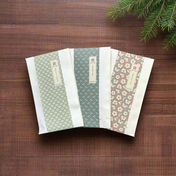The Art of Matcha Naming in the Centuries Old Matcha Industry: Unraveling the terms “Shiro” 白 and “Mukashi” 昔
In the world of traditional Japanese matcha, the terms Shiro and Mukashi carry deep cultural and historical significance, often misunderstood outside Japan. These terms are not mere descriptors but are rooted in the intricate history of tea cultivation and processing, reflecting quality, tradition, and time-honored techniques. Let’s explore their true meanings and origins, steering clear of common misinterpretations.
Mukashi: A Mark of Koicha 濃茶 Excellence
The term Mukashi (昔) is synonymous with the highest quality matcha, specifically crafted for koicha, the thick, intense tea used in formal gatherings of chanoyu—the Japanese tea “ceremony”. While the character 昔 translates to “old days” in modern Japanese, its use in matcha naming has a more precise and fascinating origin tied to the traditional lunar calendar.
In ancient Japan, the best day to harvest tea leaves for premium matcha was the 20th day of the third lunar month, roughly 20 days before the Hachijuhachiya (八十八夜), or the 88th night from the start of spring, considered the ideal time for tea picking in Kyoto (before climate change). A “20 day” period was written as 廿日 (hatsuka) in old Japanese, where the character 廿 represents “twenty” (a combination of two 十, meaning “ten”). Over time, Mukashi (昔) became a shorthand for this hatsuka harvest, symbolizing the pinnacle of matcha quality due to the tender, flavorful leaves picked during this period.
For example, Hatsu Mukashi (初昔) refers to matcha made from leaves harvested in the 20 days leading up to the 88th night, ensuring exceptional richness and depth suited for koicha. Leaves picked in the 20 days following this period might be called Ato Mukashi (後昔), though this term is less commonly used. Thus, Mukashi is a hallmark of matcha crafted with precision and care, reserved for the most refined tea ceremonies.
Shiro: The Legacy of “White” Tea
In contrast, Shiro (白), meaning “white,” denotes matcha of a slightly lower grade, typically used for usucha, the thinner, frothier tea enjoyed in casual settings. The origin of Shiro is not tied to the color of the tea itself but to a historical shift in tea processing during the 17th century, under the reign of the third shogun.
In earlier times, a tea processing method called Ao Seihou (青製法, “blue/green method”) was prevalent. This technique involved soaking tea leaves in a liquid derived from the ash of tea plants. The ash water, with its basic pH, reacted with the anthocyanin in young tea leaves, turning them a vivid green. However, this method was eventually surpassed by steaming, which lightened the leaves’ color—making them appear “whiter” in comparison—while significantly enhancing their flavor and aroma. This steaming process became the standard for matcha production, and the term Shiro emerged to describe matcha processed in this newer, flavor-forward way.
The preference for this “whiter” matcha among feudal lords during the Edo period cemented Shiro as a term for high-quality, steamed matcha, though it remains a step below Mukashi in the hierarchy of ceremonial teas. Today, Shiro matcha is prized for its balanced flavor, ideal for usucha preparation.
A Tradition Steeped in Time
The naming conventions of Mukashi and Shiro reflect more than just quality—they encapsulate Japan’s deep reverence for nature, timing, and craftsmanship. Mukashi ties the tea to a specific moment in the lunar calendar, a testament to the precision of traditional agriculture. Shiro, meanwhile, tells the story of innovation in tea processing, where flavor and aroma triumphed over color. Together, these terms offer a glimpse into the artistry and history of matcha, inviting us to savor not just the tea but the centuries of tradition it carries.
Whether you’re whisking a bowl of koicha from Hatsu Mukashi leaves or enjoying the light froth of Shiro usucha, understanding these terms deepens your appreciation for matcha’s rich cultural tapestry. Next time you sip this vibrant green tea, remember the stories of Mukashi and Shiro—a blend of time, technique, and tradition in every bowl.


